
The Benjamin Aldrich Homestead is a historic homestead east of the terminus of Aldrich Road, slightly east of Piper Hill in Colebrook, New Hampshire. Developed beginning in 1846, it is the oldest surviving farm property in the town. Its farmstead includes the original 1846 house and barns of the period. It was listed on the National Register of Historic Places in 2003, and the New Hampshire State Register of Historic Places in 2002.

The Lt. Robert Andrews House is an historic house at 428 South Bridgton Road in Bridgton, Maine, United States. Built in 1805 by John Kilborn, Jr., a local master builder, it was the home for many years of Robert Andrews, a veteran of the American Revolutionary War and an early settler of the Bridgton area. The house was listed on the National Register of Historic Places in 2005.

The William Fenderson Perry House is an historic house at 32 Main Street in Bridgton, Maine, United States. Built in 1870 and extensively remodeled in 1874, it is a fine example of transitional Italianate-Second Empire architecture, and was owned for many years by Bridgton's most prominent businessman, mill owner William F. Perry. It was listed on the National Register of Historic Places in 1975.

The Townsend Farm is a historic farmstead on East Harrisville Road in Dublin, New Hampshire. Built about 1780 and enlarged about 1850 and again at the turn of the 20th century, it is one of Dublin's older houses, notable as the home and studio of artist George DeForest Brush, one of the leading figures of Dublin's early 20th-century art colony. The house was listed on the National Register of Historic Places in 1983.

The Foster Family Home is a historic farmstead on Sunday River Road in Newry, Maine. The property includes a Greek Revival farmhouse, a barn and stable, and a cemetery in which many Fosters are interred. These improvements are situated near the Sunday River Bridge, a covered bridge spanning the Sunday River, and were developed mainly in the 19th century on land that has been in the Foster family since the early 19th century.
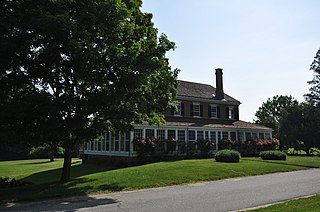
The Eastman Hill Rural Historic District is a historic district encompassing a rural landscape consisting of three 19th-century farmsteads near the village of Center Lovell, Maine. It covers 251 acres (102 ha) of the upper elevations of Eastman Hill, and is bisected by Eastman Hill Road. The area has been associated with the Eastman family since the early 19th century, and was one of the largest working farms in Lovell. Although the three properties were treated separately for some time, they were reunited in the early 20th century by Robert Eastman, a descendant of Phineas Eastman, the area's first settler. The district was listed on the National Register of Historic Places in 1993.

The John G. Coburn Farm is a historic farmstead at 434 Carthage Road in Carthage, Maine. The farmhouse, a two-story brick structure built in 1824, stands on the west side of the road just north of its crossing of the Webb River. The house is regionally distinctive as the only brick building in the Webb River valley. The farm, which now includes 29 acres (12 ha), also includes two English barns, one of which has been dated to the early 19th century. The farm was listed on the National Register of Historic Places in 2002.

The Sam Perley Farm is a historic farmstead on Perley Road in Naples, Maine. Built in 1809, it is a well-preserved local example of Federal period architecture, and is historically notable for its long association with the prominent Perley family. The farmstead includes a carriage house, wellhouse and barn, all of 19th century origin. The property was listed on the National Register of Historic Places in 1979.

The Moses Hutchins House, also known as the Kimball-Stanford House, is a historic house at the junction of Old Stage Road and Maine State Route 6 in Lovell, Maine. Built c. 1839, this two story wood-frame house and attached barn have retained their Federal period styling, while exhibiting the adaptive alteration of early farmsteads over time. The house was listed on the National Register of Historic Places in 2003.

The David Warren House is a historic house on Sam Annis Road in rural Hartford, Maine. Built in 1805, it is the only Federal period house to survive in the town, and is also one of its most imposing houses. It was built by David Warren, an early settler of adjacent Buckfield and a veteran of the American Revolutionary War. It was listed on the National Register of Historic Places in 1983.

The McCleary Farm is a historic farm complex on South Strong Road in Strong, Maine. Probably built sometime between 1825 and 1828, the main house is a fine local example of Federal style architecture. It is most notable, however, for the murals drawn on its walls by Jonathan Poor, an itinerant artist active in Maine in the 1830s. The property was listed on the National Register of Historic Places in 1989.
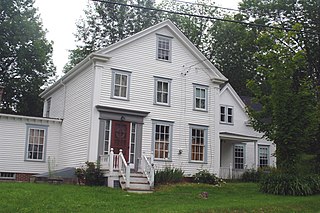
The Charles Best House is a historic house on Old County Road in West Pembroke, Maine, United States. Built in 1845, it is a fairly typical example of a mid-19th century Greek Revival connected farmstead. It is notable as the birthplace in 1899 of Charles Best (1899–1978), who is credited as a co-discoverer of insulin and the development of its therapeutic use in the treatment of diabetes. The house was listed on the National Register of Historic Places in 1982.
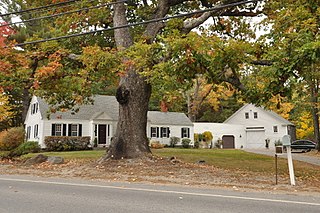
The Levi Foss House is a historic house on Maine State Route 35 on the Dayton side of the village of Goodwins Mills, Maine. Built about 1815, it is a well-preserved example of an early 19th-century connected farmstead with Federal and Greek Revival styling. It was listed on the National Register of Historic Places in 1984.

The Paul Family Farm is a historic farmstead at 106 Depot Road in Eliot, Maine. Consisting of a well-preserved early-19th century Federal style farmhouse and a small collection of early-20th century outbuildings, it is a representative example of 19th-century farming in the area. The farmhouse parlor is further notable for the c. 1820s stencilwork on its walls. The property was listed on the National Register of Historic Places in 1998.
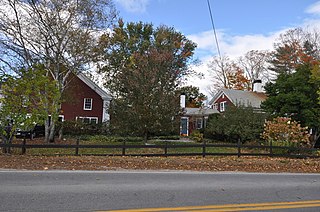
The Captain Reuel and Lucy Merrill House is a historic house at 66 Winn Road in Cumberland Center, Maine. Built in 1835, it is a well-preserved example of a connected New England farmstead with Greek Revival style. It was listed on the National Register of Historic Places in 1999.
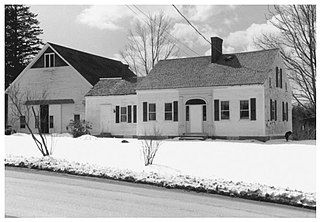
The Gushee Family House is a historic house at 2868 Sennebec Road in Appleton, Maine. Built about 1833 and remodeled in 1891, it is a well-preserved early rural Maine farmstead, with a well-preserved main entry surround that is unusually elaborate for the house's scale, but is also common to other period houses in the region. The house was listed on the National Register of Historic Places in 1998.
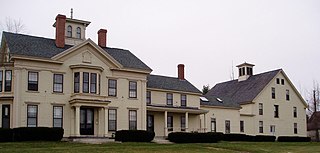
The Moses Bailey House is a historic house at 209 Winthrop Center Road in the Winthrop Center village of Winthrop, Maine. Built about 1853, with additional Italianate styling added in 1870, it is one of Winthrop's finest surviving mid 19th-century farm houses. It was listed on the National Register of Historic Places in 1984. It has been divided into apartments and is known as Bailey Manor.

The Hussey–Littlefield Farm is a historic farmstead at 63 Hussey Road in Albion, Maine. Developed between about 1838 and 1905, the farm's connected homestead exhibits the evolutionary changes of rural agricultural architecture in 19th-century Maine. The farmstead was listed on the National Register of Historic Places in 2016.
The Squire Tarbox House is a historic house at 1181 Main Road in Westport, Maine. Built in 1763 and enlarged in 1820, it is a fine local example of Georgian and Federal architecture. It was listed on the National Register of Historic Places in 1985, and is presently home to the Squire Tarbox Inn.

Drake Farm is a historic farmstead at 148 Lafayette Road in North Hampton, New Hampshire. Built in 1890, the main farmhouse is a well-preserved example of a connected New England farmstead. It was listed on the National Register of Historic Places in 2016.





















